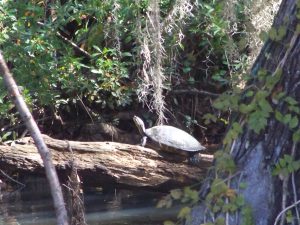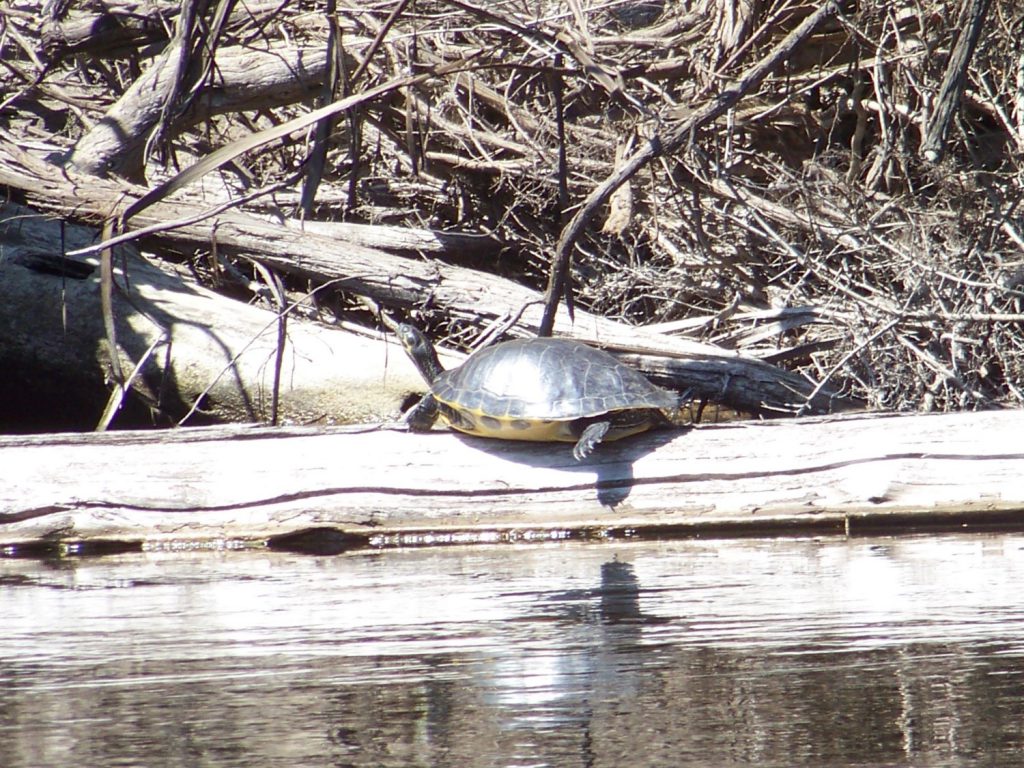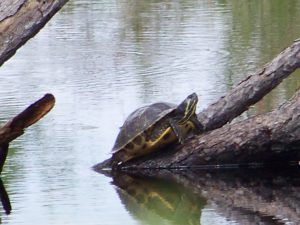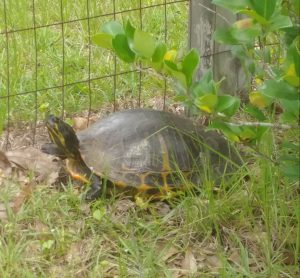Cooters are one of the more commonly seen turtles when visiting a freshwater system. They are relatively large for a freshwater turtle (with a carapace about 13 inches long) and are often seen basking on logs, rocks, aerator pumps, you name it – and often in high numbers while doing so. They spook easy and usually leap into the water long before you reach them. But because of their beautiful smooth shells and large size, they can be seen from a distance – looking like wet rocks on a tree limb.
They are in the genus Pseudemys (same as the Florida red-bellied turtles) and this genus is found throughout the southeastern United States. However, from there the breakdown of species becomes a bit challenging. There has been much debate how many species there really area, and how many are subspecies of those species. There are two distinct species for sure – the “River Cooter” (Pseudemys concinna) and the “Pond Cooter” (Pseudemys floridana). From here is gets a bit weird.
The “River Cooters” are just that – friends of rivers. They like those with a bit of a current, sand/gravel bottoms, basking spots, and grasses to eat. They have been found in estuaries, even with barnacles growing on them, so they have some tolerance for saltwater. River cooters can be distinguished from their “Pond Cooter” cousins in having a more aerodynamic shell (presumably for their habit of living in faster flowing rivers) with yellow-orange markings that form concentric rings on each scute (scale) of the carapace. Some of these seem to form a backwards “C”. Their plastron is yellow-orange but will have black markings along the margins of each scute.

This river cooter is basking on a log on the heads waters of the Choctawhatchee River in Alabama.
Photo: Molly O’Connor
The “Suwannee Cooter” is believed to be a subspecies (Pseudemys concinna suwanniensis) found in tannic rivers from the Ochlockonee just west of Tallahassee south to the Tampa Bay region. It has only been found in rivers that flow into the Gulf of Mexico. A couple of records have been found in rivers flowing towards the Atlantic, but it is believed these were relocated by humans.
The “Eastern River Cooter” is found from the Ochlockonee River west to Mobile Bay – possibly as far as Louisiana. There has been a suggestion that the one west of Mobile Bay is the “Mobile Cooter” (Pseudemys concinna mobilensis) but the naming of this group, again, has been a bit crazy.
As mentioned, “Pond Cooters” are fans of slow-moving waters with muddy bottoms. Unlike river cooters, pond cooters will travel over land other than to lay eggs. Many of their “pond” selections dry up and they must find new habitat. Like river cooters, pond cooters feed on vegetation so aquatic plants are must and they also like to bask in the sun on logs with many cooters basking at once.
Physically they differ from river cooters in having a slightly domed shell near the head end. The yellow markings are not concentric, but rather are in straight lines and their plastrons are an immaculate beautiful yellow – with no markings on the margins. They do however have black circles on the bottom margins of their carapace. These are usually round with a small yellow spot in the center – resembling an “o”.
There is believed to be two subspecies of this group. Pseudemys floridana floridiana (the “Florida Cooter”) and Pseudemys floridana peninuslaris (the “Peninsula Cooter”). Told you it was all weird. The Florida cooter is found in the Florida panhandle and the Peninsula Cooter has been found all the way to the Florida Keys – though it does not seem to be common in the Everglades.
Add to the quagmire of species identification – there is hybridization between not only the types of pond and river cooters – but BETWEEN the pond and river cooters. So, if you live in the eastern panhandle where all of these seem to converge – just call them “cooters”!
They have an interesting nesting habit. When the females approach an open sunny sandy spot, she will dig a hole to lay about 20 eggs, but she will also dig two “satellite” nests on either side – and maybe place an egg or two in there. It is quite understood why they do this, but they do. They also may come to the beach up to five times in one year to lay eggs.
Because of their high numbers and large size, this has been a favorite food item for humans for quite some time. Due to this, and the practice of shooting them off their basking spots, and alterations of river systems lower the habitat quality for the river cooters, their numbers have declined. The Suwannee Cooter in particular has been hard hit and is a species of concern. Due to this it no longer allowed to harvest them (or their eggs) from the wild. Because it is so hard to tell the Suwannee from other species/subspecies of cooters – ALL cooters are now protected by the Florida Fish and Wildlife Conservation Commission.
Another note – they do not eat fish. The young will eat worms and insects, but the adults are strictly herbivores. Many pond owners want to shoot them thinking they are eating the stocked fish by the landowner. They will not eat the fish – you are fine.
I think these are amazingly beautiful animals to see glimmering in the sunny on their basking logs as you explore our local rivers and wetlands. I hope you find them just as cool and appreciate them.
Resources:
Buhlman, K., T. Tuberville, W. Gibbons. 2008. Turtles of the Southeast. University of Georgia Press, Athens GA. 252 pp.
Florida Fish and Wildlife Conservation Commission. Freshwater Turtles https://myfwc.com/wildlifehabitats/wildlife/freshwater-turtles/.
Meylan, P.A. (Ed.). 2006. Biology and Conservation of Florida Turtles. Chelonian Research Monographs No.3, 376 pp.
- Rattlesnakes on Our Barrier Islands; Part 4 – Thermoregulation - December 29, 2025
- Rattlesnakes on Our Barrier Islands; Part 3 – Envenomation - December 22, 2025
- St. Joe Red Tide Claiming Terrapins - December 15, 2025



